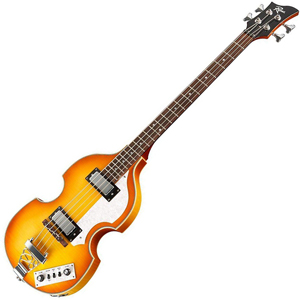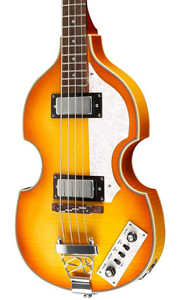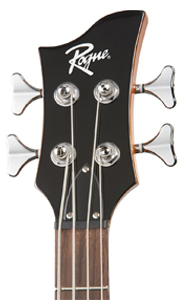- Home
- Instruments
- Gear
- Recording
- Lessons
- Reviews
- Blog


| Body And Neck: |  |
| Electronics: |  |
| Hardware: |  |
| Sound: |  |
| Value: |  |
Whenever you step into the affordable and entry-level segment of the market, the usual stuff you're going to see are various bass guitars that feature a Jazz Bass type configuration. A solid body is something you don't even question. Then, all of a sudden you spot the Rogue VB100 Violin Bass.
Not only does it break the narrative, but it infuses this part of the market with something much more refined. How good is it? Can it even keep up with the rest of its class? Let's just say it's among the best axes you can find for around $300. Check out how it compares to other impressive models from this segment in our special piece.

Figuring out why it's called a violin bass is simple – just open the box and take a quick look. The body is a hollow design that features the classic arched top violin shape. Tonewood of choice is maple all around, including the top and the bottom. The neck is a much more familiar piece that sports a nice rosewood fretboard. With that said, you will most likely need to take it straight to a luthier for a proper setup. While it's a pretty nice old school bass, Rogue's quality control is not always on top of their game, which is odd considering this bass is made in the same factory where Epiphone makes their stuff.
Unlike all of the models on the list so far, Rogue VB100 Violin Bass features a rosewood bridge supported by a trapeze tailpiece. This type of design is something you can find on various Gretsch models in one version or another. The bridge is solid and keeps the instrument in key, but adjusting it is a pain. However, that is the case with all guitars or bass guitar that feature such a design. Tuning machines are die-cast pieces, but they also perform pretty well.
In terms of electronics, we have a set of mini humbuckers located at the bridge and neck position. These are controlled by individual volume knobs, and a three-way EQ cluster. All things considered, the humbuckers on this bass are aligned with the overall theme of the VB100. They are capable of delivering that vintage tone and actually benefit from the hollow body design.

When it comes to sound, VB100 simply shines. With a functional three-band EQ, this bad boy definitely has a lot of range. However, it's the type of bass you would want to play metal with. The tone is refined and carries that special kind of warmth only a hollow body design can give you. If we had to choose, we would say that classic rock is the home turf for VB100. Same goes for blues and jazz. Going beyond these genres might be a stretch.
While it is definitely a type of bass guitar that an experienced bass player might be interested in, a beginner would most likely find it too complicated to learn on. If you think about it, Rogue managed to deliver a hollow body bass that sounds decent in a price range where you rarely find good solid body models. That speaks volumes.
For more info about the Rogue VB100, click here.
For more Bass Guitars under $300, click here.

Tom says
I was given a rogue violin bass by someone who was cleaning out his basement. Going to change strings and have a set up done. Very different from my other basses but it does have that Beatles sound and it plays fairly well considering what it is.
Frank says
I own a real hofner and a rogue.I have to say that the rogue is no no slouch compared to the hofner.
Sam says
Ok.. I feel like an idiot but I can’t figure out how to remove a string (and then restring) my own used VB100. The ball on the end of the current string won’t slide past the decorative tailpiece cover.. the ball ends on my replacement strings are bigger than the ones currently on the instrument.
Any thoughts or suggestions? Sorry for my newbie-ness..
Bob says
Hey Sam,
To remove the strings, simply loosen them, and unscrew the two elongated “nuts” on the tailpiece. The ones that face the bridge. You will need a wrench so be careful not to scratch them.
This will allow you to slide the ball ends out of the tailpiece. After fitting new strings, simply reverse the process and tighten up the “nuts”.
David R says
I got a Rogue beatles bass, and it had a high fret that made it fret out badly. I had to beat it down with a hammer and the flat side of a crescent wrench but then it was fine. Yes I changed strings and had trouble getting them to go in the bridge holes, so you’d better have light gauge. It sounds really great since I put some flatwounds on it, – light years better.